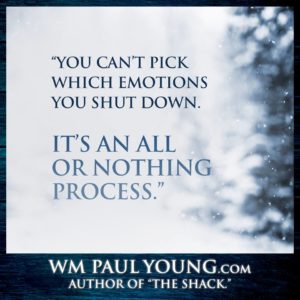“Negative emotions like loneliness, envy, and guilt have an important role to play in a happy life; they’re big, flashing signs that something needs to change.”
–Gretchen Rubin
I was reading, signing and stuffing year-end receipts the other day and ended up with a deep paper cut on the index finger of my right hand. Ouch! I ran and got a Band-Aid, so I wouldn’t bleed all over the receipts and finished the job.
I forgot about the paper cut until I got home and started preparing dinner. The Band-Aid got wet and slimy and I finally just took it off. That paper cut reminded me many times that night and the next morning that it was still there, ready to sting and hurt at the least provocation.

I started thinking about that paper cut and how we process negative or painful emotions. We are a society, or maybe it’s just a baby boomer characteristic, that loves to stuff our emotions. It’s really not cool to cry and besides that, I’m an ugly crier. Hurt, regret, betrayal, grief (you can add your own) all get Band-Aids and then we move on and we move on quickly. Or is this just my imagination?
Sometime down the road in our lives those Band-Aids get slimy and fall off and most of the time we forget why we had the Band-Aids anyway. But the sting is still there, ready to be triggered again, like the paper cut. I was reminded of it when I tried to open the pickle jar…when Truffle pulled on her leash…when I turned on the water faucet. Lifting weights, even though I wore gloves, reminded me how tender it still was.
Our emotions can be triggered time and again until we take the time to become aware of the tenderness and why we feel it. How can we identify and heal old emotions? From my experience, here are some steps:
1. When the negative or undesirable emotion arises, identify what triggered it. What was happening when the emotion came up? Become aware the circumstance. Maybe even write it down. I’ll give you an example from a long time ago. Every time my husband would arrive home late, I used to get really angry no matter what the reason for his lateness.
2. What about that circumstance triggered the emotion? I had to stay in that question for a while. Eventually, I came to the conclusion that every time Dad came home late, Mom went ballistic. Dad occasionally stopped off to have a few drinks before he came home. Mom always made this fabulous dinner and by the time Dad got home all the kids were grumpy and hungry. That fabulous dinner was cold. Mom was got angry.
 3. Once aware, our thinking surrounding the emotion and the circumstance can be changed. Once I realized what triggered the emotion behind Hubby’s tardiness and how I had projected Dad’s behavior onto my hubby, I worked through my hubby’s occasional behavior…it stopped bothering me so much. It did take some time to change the emotions I felt, because I was a youngster when I first witnessed Mom and Dad’s behavior.
3. Once aware, our thinking surrounding the emotion and the circumstance can be changed. Once I realized what triggered the emotion behind Hubby’s tardiness and how I had projected Dad’s behavior onto my hubby, I worked through my hubby’s occasional behavior…it stopped bothering me so much. It did take some time to change the emotions I felt, because I was a youngster when I first witnessed Mom and Dad’s behavior.
I am not a psychologist, but in coaching other people, I have found that escaping or forgetting about these negative emotions doesn’t send them packing. They will remind us of their existence with each circumstance, rejection, or betrayal that brings them up again. Grief is not a negative emotion, but it needs to be processed and worked through just like the other emotions.
Truly dealing with and processing negative emotions helps us move forward into becoming the best version of ourselves. We will have more peace and happiness because we know ourselves better. Our relationships improve. We know how to stop the undesirable reactions before they start. In my life, this has brought tremendous freedom.
What does this have to do with leadership? To be effective, leaders must have a solid understanding of how their emotions and actions affect the people around them. The better a leader relates to and works with others, the more successful he or she will be.
Have some questions or need some help? I’m just an email or phone call away.
Jan
Jan McDonald
The John Maxwell Team
(still CEO of Life Options)
For a friend to subscribe, here is the link
https://tinyurl.com/janmcdonald
www.johncmaxwellgroup.com/janmcdonald
https://www.linkedin.com/in/janmmcdonald/

Comments are closed.